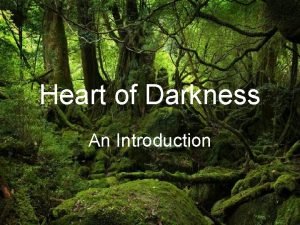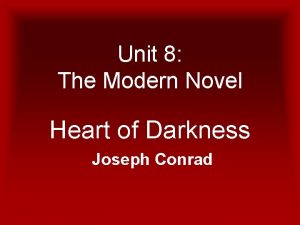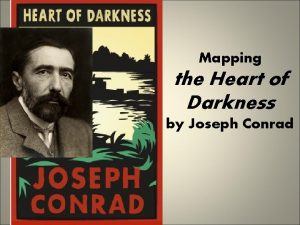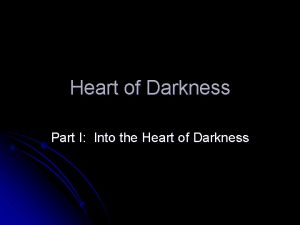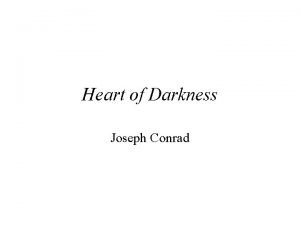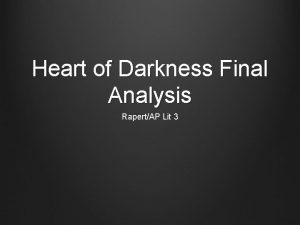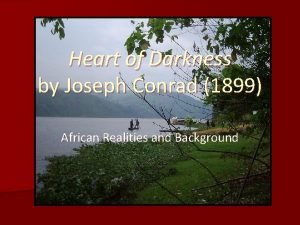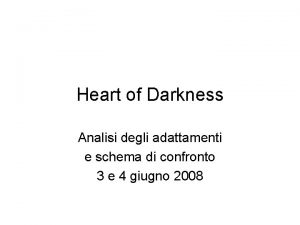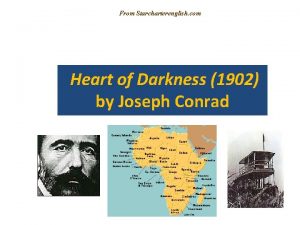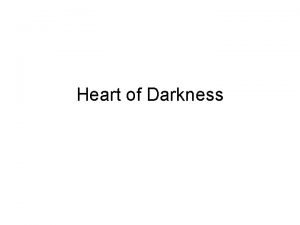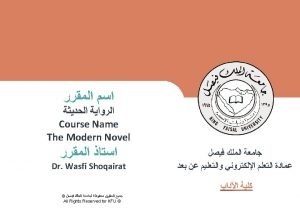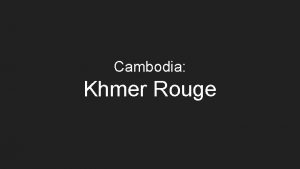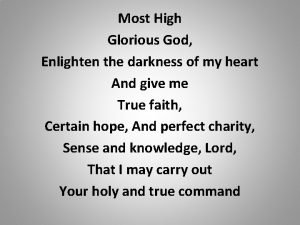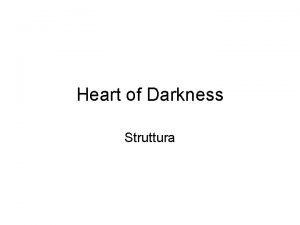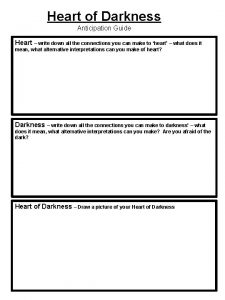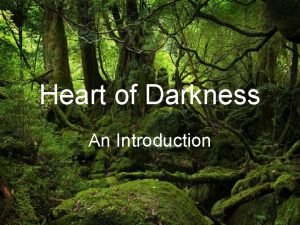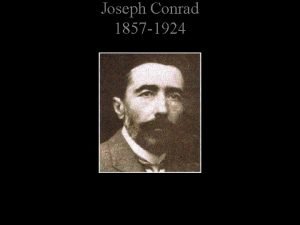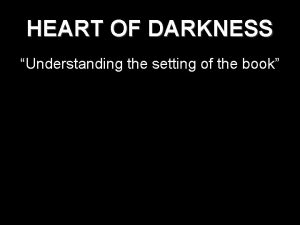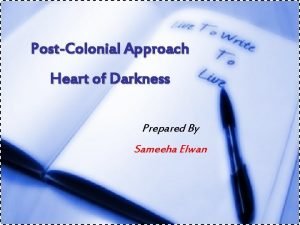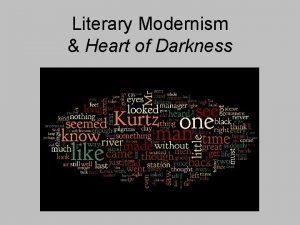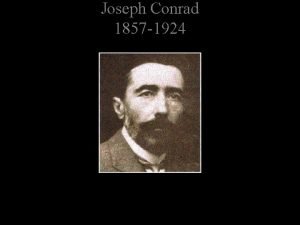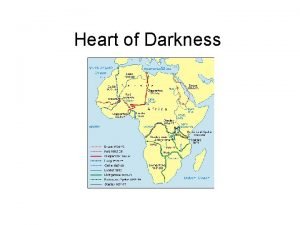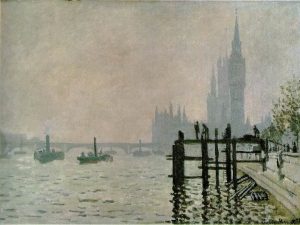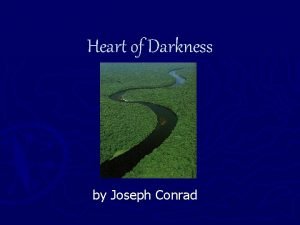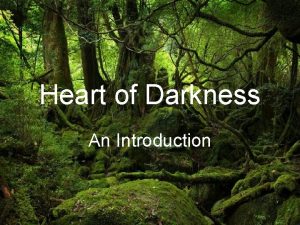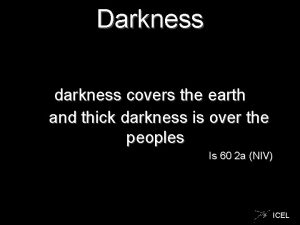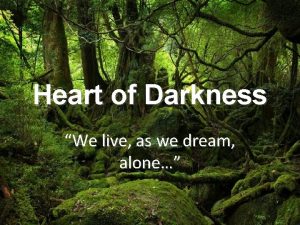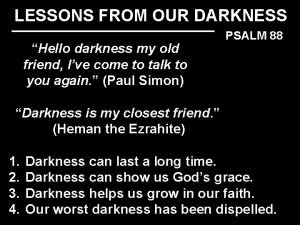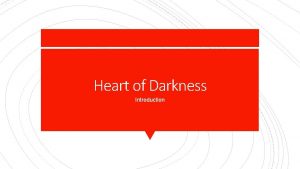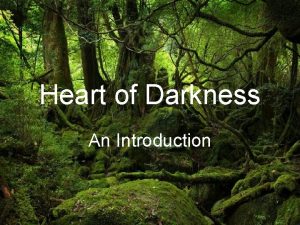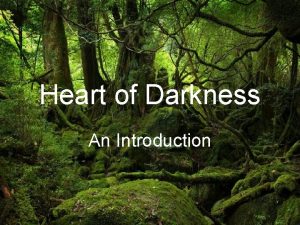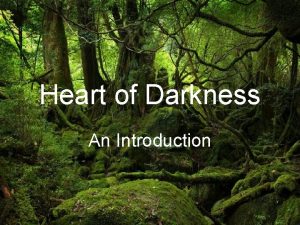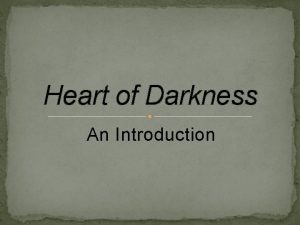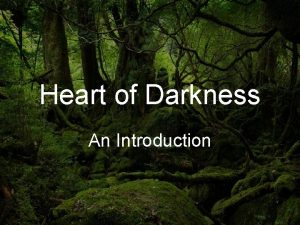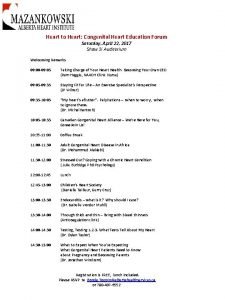Heart of Darkness An Introduction We live as



























- Slides: 27

Heart of Darkness An Introduction “We live as we dream, alone…”

Impressionism

Impressionism

Impressionism

Why the Blurriness? • For modern novelists, the messiness, confusion, and darkness of experience is interesting. • Rather than trying to simplify and abstract a particular meaning from experience, novelists tend to wallow in the multiplicity of ideas and meanings and sensations that experience can provide.

Why the Blurriness? • Novelists are in the business of recreating and communicating the rich complexities of the experience itself. • Their purpose is to get the reader to relive an experience, with all its complexity and messiness, all its darkness and ambiguity.

Conrad’s View • For Conrad, the world as we experience it is not a sort of place that can be reduced to a set of clear, explicit truths • Its truths—the truths of the psyche, of the human mind and soul—are messy, vague, irrational, suggestive, and dark • Conrad’s intention? : to lead his readers to an experience of the “heart of darkness. ” Not to shed the light of reason on it…but to recreate his experience of darkness in our feelings, our sensibilities, our own dark and mysterious hearts

About the Novel • Since its publication, Heart of Darkness has fascinated readers and critics, almost all of whom regard the novel as significant because of its use of ambiguity and (in Conrad's own words) "foggishness" to dramatize Marlow's perceptions of the horrors he encounters. • Critics have regarded Heart of Darkness as a work that in several important ways broke many narrative conventions and brought the English novel into the twentieth century.

About the Author • Joseph Conrad – Born in 1857 in Russian-occupied Poland – Joined the French Merchant Marine at 16 – Kicked out due to his nationality – Joined the British Merchant Marine in 1878 – Left the sea and began writing in 1894 – Died in 1924 and buried in Canterbury, England

About the Author • Spent time in East Asia • Worked for a Belgian trading company • Dreamed of sailing the Congo in Africa – He always felt he was never mentally or physically prepared for that kind of journey • Witnessed: ill-treatment of the natives; terrible heat and lack of clean water; human skeletons left to rot; dysentery and malaria

About the Author • Conrad’s time in the Congo (only 3 months) was long enough to leave an intense impression of the atrocities he witnessed • The country at the center of Heart of Darkness is called the Democratic Republic of the Congo – In Conrad’s time it was the Congo Free State, or Belgian Congo

Historical Context

The Congo • It was not until 1877, after the English-born American explorer Henry Morton Stanley had completed a three-year journey across central Africa, that the exact length and course of the mighty Congo River were known. Stanley discovered that the Congo extends some 1, 600 miles into Africa from its eastern coast to its western edge, where the river empties into the Atlantic Ocean, and that only one stretch of it is impassable. That section lies between Matadi, two hundred miles in from the mouth of the Congo, and Kinshasa, yet another two hundred miles further inland. In Heart of Darkness, Conrad calls Matadi the Company Station and Kinshasa the Central Station. Between those two places, one is forced to proceed by land, which is exactly what Marlow does on his "two hundred-mile tramp" between the two Stations, described in the book.

Belgian Congo/Zaire

King Leopold II • In 1878, King Leopold II of Belgium asked Stanley to found a Belgian colony in the Congo. The King charged Stanley with setting up outposts along the Congo River, particularly at Matadi. Leopold II described his motives to the rest of Europe as springing from a desire to end slavery in the Congo and civilize the natives, but his actual desires were for material gain. In 1885, at the Congress of Berlin, an international committee agreed to the formation of a new country to be known as the Congo Free State. In Heart of Darkness, Conrad refers to this committee as the International Society for the Suppression of Savage Customs. Leopold II, who was to be sole ruler of this land, never set foot in the Congo Free State. Instead, he formed a company, called simply “the Company” in Heart of Darkness, that ran the country for him.

The Ivory Trade • A prevalent feeling among Europeans of the 1890 s was that the African people required introduction to European culture and technology in order to become more evolved. The responsibility for that introduction, known as the "white man's burden, " gave rise to a fervor to bring Christianity and commerce to Africa. What the Europeans took out of Africa in return were huge quantities of ivory. During the 1890 s, at the time Heart of Darkness takes place, ivory was in enormous demand in Europe, where it was used to make jewelry, piano keys, and billiard balls, among other items. From 1888 to 1892, the amount of ivory exported from the Congo Free State rose from just under 13, 000 pounds to over a quarter of a million pounds. Conrad tells us that Kurtz was the best agent of his time, collecting as much ivory as all the other agents combined.

The Ivory Trade • In 1892, Leopold II declared all natural resources in the Congo Free State to be his property. This meant the Belgians could stop dealing with African traders and simply take what they wanted themselves. As a consequence, Belgian traders pushed deeper into Africa in search of new sources of ivory, setting up stations all along the Congo River. One of the furthermost stations, located at Stanley Falls, was the likely inspiration for Kurtz's Inner Station.

Belgian Atrocities in the Congo • The Belgian traders committed many well -documented acts of atrocity against the African natives, including the severing of hands and heads.

Belgian Atrocities in the Congo • Reports of these atrocities reached the European public, leading to an international movement protesting the Belgian presence in Africa. These acts, reflected in Heart of Darkness, continued, despite an order by Leopold II that they cease. In 1908, after the Belgian parliament finally sent its own review board into the Congo to investigate, the king was forced to give up his personal stake in the area and control of the Congo reverted to the Belgian government. The country was granted its independence from Belgium in 1960, and changed its name from the Democratic Republic of Congo to Zaire in 1971.

Key Facts • Full Title: Heart of Darkness • Author: Joseph Conrad • Type of Work: Novella (between a novel and a short story in length and scope) • Genre: colonial literature, adventure tale, frame story, almost a romance in its insistence on heroism and the supernatural and its preference for the symbolic over the realistic

Key Facts • Time and Place Written: England, 1898– 1899; inspired by Conrad’s journey to the Congo in 1890 • Date of First Publication: Published in 1902 in the volume Youth: A Narrative; and Two Other Stories • Narrator: There are two narrators: an anonymous passenger on a pleasure ship, who listens to Marlow’s story, and Marlow himself, a middleaged ship’s captain. • Point of View: The first narrator speaks in the firstperson plural, on behalf of four other passengers who listen to Marlow’s tale. Marlow narrates his story in the first person, describing only what he witnesses and experiences, and provides his own commentary on the story.

Key Facts • Tone: Ambivalent: Marlow is disgusted at the brutality of the Company and horrified by Kurtz’s degeneration, but he claims that any thinking man would be tempted into similar behavior. • Setting (time): Latter part of the nineteenth century, probably sometime between 1876 and 1892 • Setting (place): Opens on the Thames River outside London, where Marlow is telling the story that makes up Heart of Darkness. Events of the story take place in Brussels, at the Company’s offices, and in the Congo, then a Belgian territory. • Protagonist: Charlie Marlow

Key Facts • Themes: The hypocrisy of imperialism; madness as a result of imperialism; the absurdity of evil; discovery of truth • Motifs: – Darkness (very seldom opposed by light), – Interiors vs. surfaces (kernel/shell) • Coast/inland, station/forest, etc. , – – Hyperbolic language, Inability to find words to describe situation adequately, Images of ridiculous waste, Upriver versus downriver / toward and away from Kurtz / away from and back toward civilization (quest or journey structure.

Order in the midst of Chaos HOD’s Structure • Things in Threes: – – – Chapters Marlow breaks off story 3 times Stations Women Central Characters • Frame Narrative (story within a story) • Light and Dark • Transformation

Ambiguity / Clarity • Multiplicity, ambiguity, and irony are not the easiest forms of expression to cope with when you are a student and asked to express yourself clearly and directly. But it is precisely because the world appears to us to be multiple, ambiguous, and ironic that we must strive to speak and write clearly. • Otherwise—there is only darkness, only confusion.

About the Novel • Some notable exceptions who didn't receive the novel well: – British novelist E. M. Forster, who disparaged the very ambiguities that other critics found so interesting – African novelist Chinua Achebe, who derided the novel and Conrad as examples of European racism.

Questions to Consider as you Read: • What does it mean to be savage? • Civilized? • What are the different meanings of the words “dark” and “light”? • Why do people choose to do good? evil?
 Heart of darkness historical context
Heart of darkness historical context Heart of darkness as a modern novel
Heart of darkness as a modern novel The heart of darkness map
The heart of darkness map Heart of darkness symbol
Heart of darkness symbol The heart of darkness summary
The heart of darkness summary Summary of heart of darkness
Summary of heart of darkness Heart of darkness part 3 quotes
Heart of darkness part 3 quotes Heart of darkness
Heart of darkness Heart of darkness soluzioni
Heart of darkness soluzioni Heart of darkness theme
Heart of darkness theme Heart of darkness setting
Heart of darkness setting Heart of darkness part 2 summary
Heart of darkness part 2 summary Heart of darkness cambodia
Heart of darkness cambodia Heart of darkness mla citation
Heart of darkness mla citation Enlighten the darkness of my heart
Enlighten the darkness of my heart Tim roth heart of darkness
Tim roth heart of darkness Heart of darkness shmoop
Heart of darkness shmoop Heart of darkness as a modern novel
Heart of darkness as a modern novel Heart of darkness part 3
Heart of darkness part 3 Setting of heart of darkness
Setting of heart of darkness Edward said two visions in heart of darkness
Edward said two visions in heart of darkness Heart of darkness modernism
Heart of darkness modernism Heart of darkness racism quotes
Heart of darkness racism quotes What is impressionistic writing
What is impressionistic writing Heart of darkness map
Heart of darkness map Heart of darkness map
Heart of darkness map Heart of darkness motifs
Heart of darkness motifs Impressionism in heart of darkness
Impressionism in heart of darkness
